Some Results of Biharmonic Maps
2016-09-22FENGShuxiangPANHong
FENG Shu-xiang,PAN Hong
(College of Mathematics and Information Science,Xinyang Normal University,Xinyang 464000,China)
Some Results of Biharmonic Maps
FENG Shu-xiang,PAN Hong
(College of Mathematics and Information Science,Xinyang Normal University,Xinyang 464000,China)
In this paper,we investigate biharmonic maps from a complete Riemannian manifold into a Riemannian manifold with non-positive sectional curvature.We obtain some non-existence results for these maps.
biharmonic maps;harmonic map
2000 MR Subject Classification:58E20,53C21
Article ID:1002—0462(2016)01—0019—08
Chin.Quart.J.of Math.
2016,31(1):19—26
§1. Introduction


We see that harmonic maps are biharmonic maps and even more,minimizers of the bienergy functional.After G Y Jiang[7]studied the first and second variation formulas of the bienergy E2,there have been extensive studies on biharmonic maps(for instance,see[4,7,10-11,14,16-18].
For harmonic maps,it is well known that:If a domain manifold(M,g)is complete and has non-negative Ricci curvature and the sectional curvature of a target manifold(N,h)is non-positive,then every energy finite harmonic map is a constant map(cf[15]).
For biharmonic maps,it is known that:If a non-compact Riemannian manifold(M,g)is complete and has non-negative Ricci curvature and(N,h)has non-positive sectional curvature,then every bienergy finite biharmonic map of(M,g)into(N,h)is harmonic(cf[2]).
Recently,N Nakauchi,H Urakawa and S Gudmundsson[14]proved that biharmoic map from a complete Riemannian manifold into a non-positive curved manifold with finite bienergy and energy are harmonic.S Maeta[13]proved that biharmoic map from a complete Riemannian manifold into a non-positive curved manifold with finite p-bienergy∫M|τ(u)|pdvg<∞(p≥2)and energy is harmonic.Y Luo[12]proved that biharmoic map from a complete Riemannian manifold into a non-positive curved manifold which has at least one hyperbolic point with finite p-bienergy∫M|τ(u)|pdvg<∞(p≥2)is harmonic.
Definition 1.1Let(N,h)be a Riemannian manifold.We say a point x0∈N is a hyperbolic point,if the sectional curvature of any tangent plane at x0is negative.
In this paper,we will show that

(a)Every biharmonic map u:(M,g)→(N,h)with finite energy and∫MF(|τ(u)|2)dvg<∞is harmonic.
(b)In the case Vol(M,g)=∞,every biharmonic map u:(M,g)→(N,h)with∫MF(|τ(u)|2)dvg<∞is harmonic.
(c)In the case N has at least one hyperbolic point and rank(du)≠1,every biharmonic map u:(M,g)→(N,h)with∫MF(|τ(u)|2)dvg<∞is harmonic.
§2. Preliminaries
In this section we give more details for the definitions of harmonic maps,biharmonic maps and biharmonic submanifolds.
Let u:(M,g)→(N,h)be a map from an m-dimensional Riemannian manifold(M,g)to an n-dimensional Riemannian manifold(N,h).The energy of u is defined by

The Euler-Lagrange equation of E is

where we denote by▽the Levi-Civita connection on(M,g)andthe induced Levi-civita connection onis an orthonormal frame field on(M,g).τ(u)is called the tension field of u.A map u:(M,g)→(N,h)is called a harmonic map if τ(u)=0.
To generalize the notion of harmonic maps,in 1983 J Eells and L Lemaire[5]proposed considering the bienergy functional

In 1986,G Y Jiang[7]studied the first and second variation formulas of the bienergy E2.The Euler-Lagrange equation of E2is

We also recall biharmonic submanifolds.
Let u:(M,g)→(N,h=〈·,·〉)be an isometric immersion from an m-dimensional Riemannian manifold into an n-dimensional Riemannian manifold.We identify du(X)with X∈Γ(TM)for each x∈M.We also denote by〈·,·〉denote the induced metric u-1h.The Gauss formula is given by

where B is the second fundamental form of M in N.The Weingarten formula is give by

where Aξis the shape operator for a unit normal vector field ξ on M and▽⊥denotes the normal connection on the normal bundle of M in N.For any x∈M,the mean curvature vector field H of M at x is given by
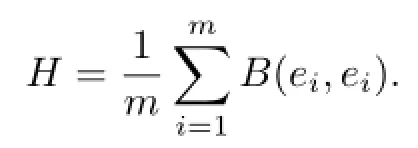
If an isometric u:(M,g)→(N,h)is biharmonic,then M is called a biharmonic submanifold in N.In this case,we remark that the tension field τ(u)of u is written τ(u)=mH,where H is the mean curvature vector field of M.The necessary and sufficient condition for M in N to be biharmonic is the following:

We also need the following Lemma.
Lemma 2.1(Gaffney)[6]Let(M,g)be a complete Riemannian manifold.If a C1a-form α satisfies that∫M|α|dvg<∞and∫M(δα)dvg<∞or equivalently,a C1vector X defined by α(Y)=〈X,Y〉(∀Y∈Γ(TM))satisfies that∫M|X|dvg<∞and∫Mdiv(X)dvg<∞,then

§3.Proof of Theorem 1.2
In this section we will give a proof of Theorem 1.2
Proof Take a fixed point x0∈M and for every r>0,let us consider the following cut off function λ(x)on M

where Br(x0)={x∈M:d(x,x0)<r},C is a positive constant and d is the distance of(M,g). From(1),we have

Since the sectional curvature of(N,h)is non-positive.From(4),we have
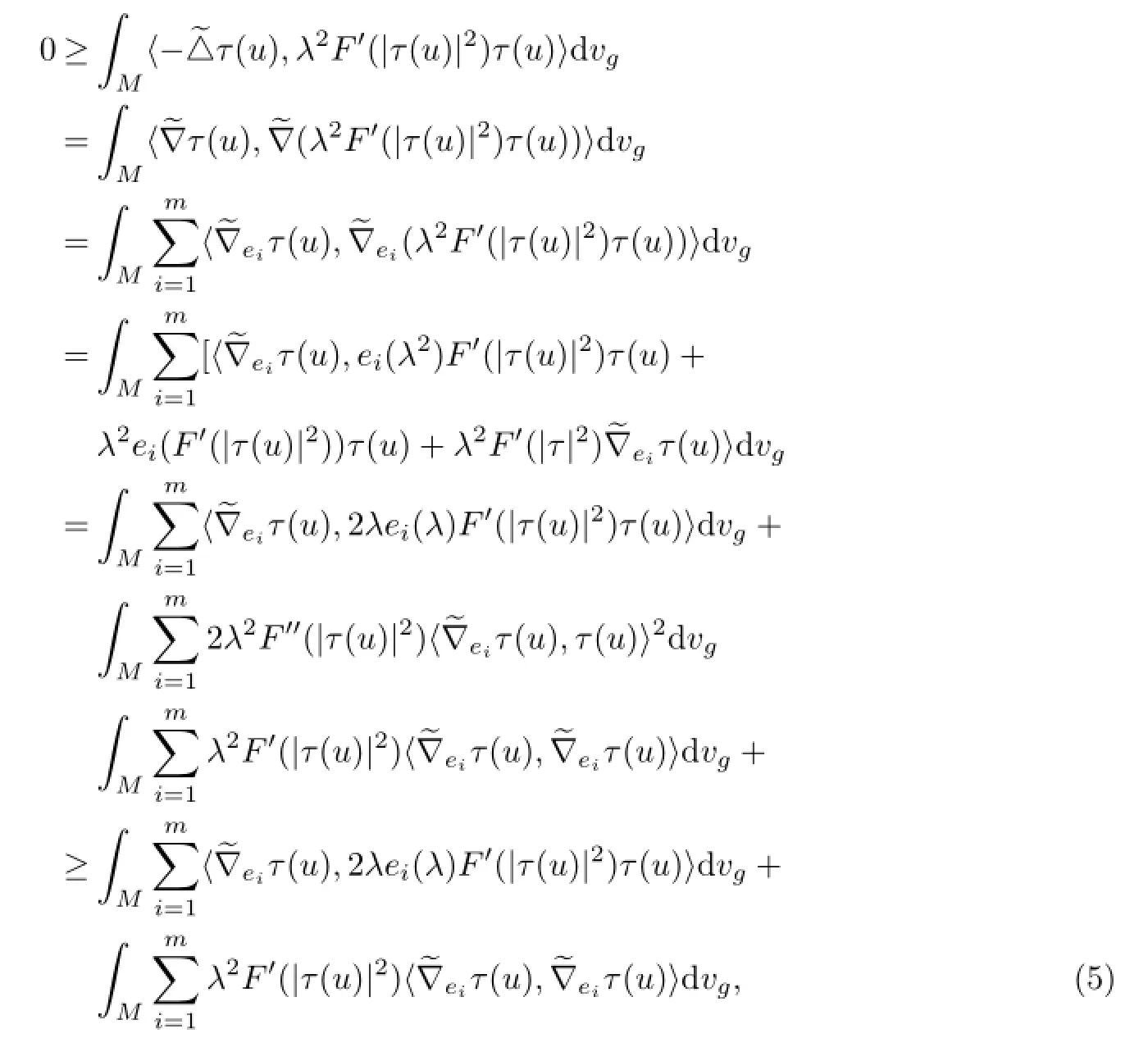
where the inequality follows fromFrom(5),we have

By using the Cauchy-Schwarz inequality,we have

From(6)and(7),we have
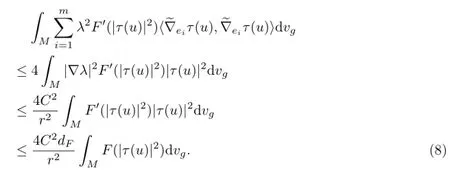
By assumption∫MF(|τ(u)|2)dvg<∞,the right hand side of(8)goes to zero and left hand side of(8)goes to

if r→∞,since λ=1 on Br(x0).Thus we have

Therefore,we obtain that|τ(u)|is constant andfor any vector field X on M.
Therefore,if Vol(M)=∞and|τ(u)≠0|,then

which yields a contradiction.Thus,we have|τ(u)|=0,i.e.,u is harmonic.We have(b).
For(a),assume both∫MF(|τ(u)|2)dvg<∞and∫M|du|2dvg<∞.Define a 1-from α on M defined by

for any vector X∈Γ(TM).
Note here that

Now we compute
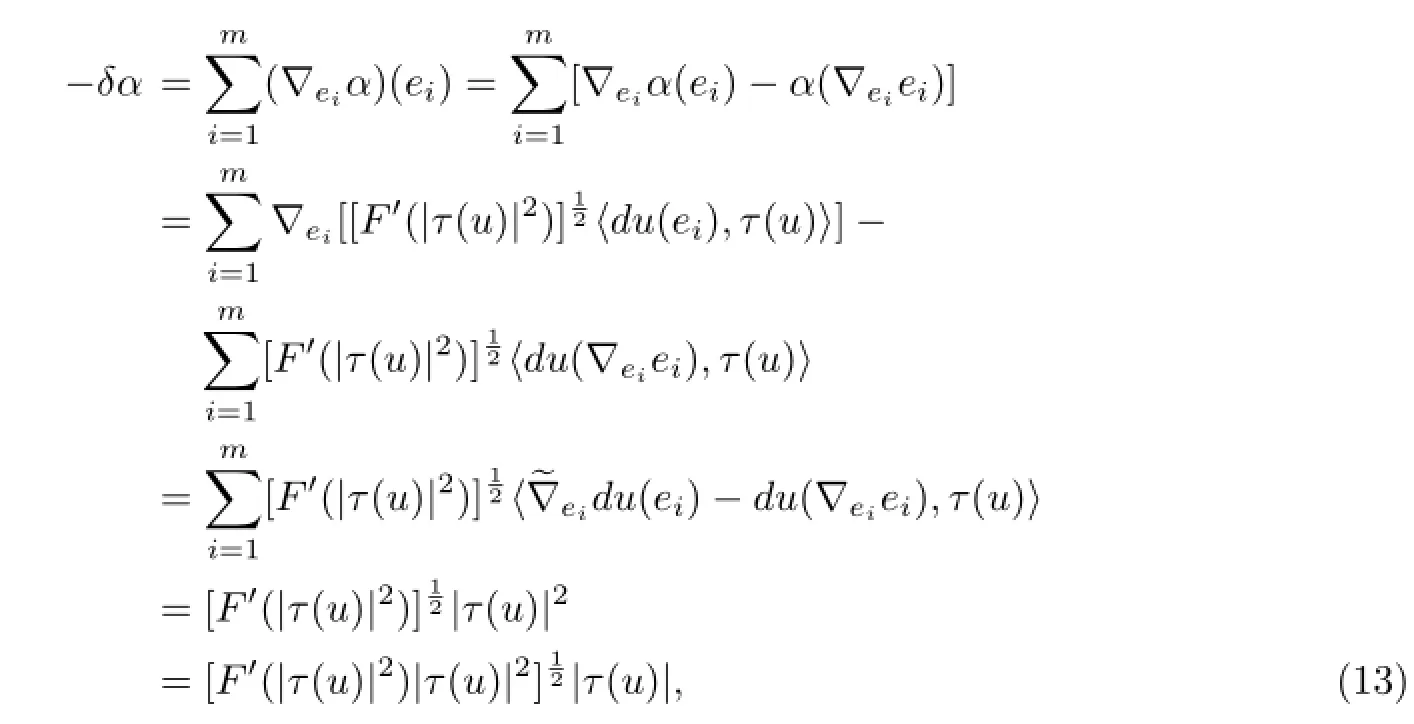
where the fourth equality follows from that|τ(u)|is constant andFrom(13),we have

Since∫MF(|τ(u)|2)dvg<∞and|τ(u)|is constant,the function-δα is also integrable over M. From this and(12),we can apply Lemma 2.1 for the 1-from α.Therefore we have

so we have τ(u)=0,that is,u is harmonic.
For(c),since∫MF(|τ(u)|)dvg<∞,we obtain that|τ(u)|is constant andfor any vector field X on M.We only need to prove that c=0.If not,assume that y0is a hyperbolic point on N;then by smoothness we see that there is a neighborhood around y0∈U⊂N where every point is hyperbolic.Now we discuss two possibilities.
(i)du=0 everywhere in U.Then τ(u)=Trace(▽du)=0 in U,i.e.,c=0.
(ii)There exists a hyperbolic point y1∈U and q∈M,u(q)=y1,such that duqis non-degenerate.We choose geodesic coordinates{xi,i=1,···,m}on M around q such that duV(∂x1)≠0(possibly in a smaller neighborhood V of q).Then by the F-biharmonic equation andfor any vector field X on M,we have in V,
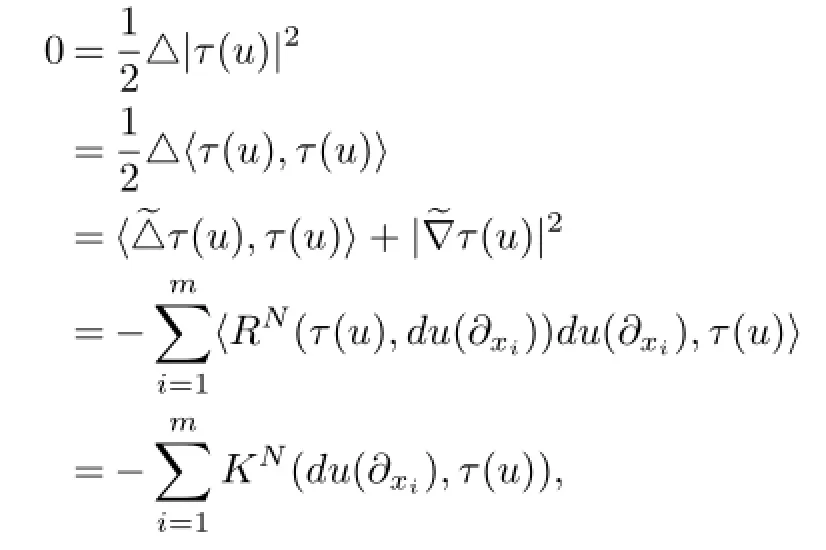
where KN(du(∂xi),τ(u))denotes the sectional curvature at y0of the tangent plane spanned by du(∂xi)and τ(u),i=1,···,m.Since duV(∂x1)≠0 and rank(du)≠1,we have rank(du)|V≥2,there exists a vector field du(∂xj)such that du(∂xj)is not parallel to τ(u),we have

a contradiction.
If a biharmonic map u:(M,g)→(N,h)is an isometric immersion,that is,M is a biharmonic submanifold in N,we obtain the following result.


then u is harmonic.

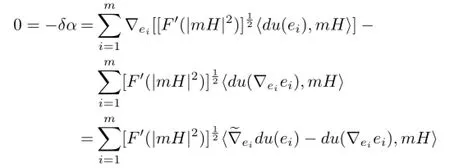

Therefore M is minimal,that is,u is harmonic.
[References]
[1]ARA M.Geometry of F-harmonic maps[J].Kodai Math J,1999,22:243-263.
[2]BAIRD P,FARDOUN A,OUAKKAS S.Liouville-type theorems for biharmonic maps between Riemannian manifolds[J].Adv Calc Var,2010,3:49-68.
[3]CADDEO R,MONTALDO S,PIU P.On biharmonic maps[J].Contemp Math,2001,288:286-290.
[4]CHIANG Yuan-jen.Developments of Harmonic Maps,Wave Maps and Yang-Mills Fields into Biharmonic Maps,Biwave Maps and Bi-Yang-Mills Fields[M].Basel:Springer Basel,2013.
[5]EELLS J,LEMAIRE L.Selected Topics in Harmonic Maps[M].Rhode Island Providence:American Mathematical Society,1983.
[6]GAFFNEY M P.A special Stoke’s theorem for complete Riemannian manifold[J].Ann Math,1954,60:140-145.
[7]JIANG Guo-ying.2-harmonic maps and their first and second variational formulas[J].Chinese Ann Math,1986,7A:388-402;the English Translation,Note di Matematica,2009,28:209-232.
[8]JIANG Guo-ying.The conservation law for 2-harmonic maps between Riemannian manifolds[J].Acta Math Sin,1987,30:220-225.
[9]LIU Jian-cheng.Liouville theorems of stable F-harmonic maps for compact convex hypersurfaces[J].Hiroshima Math J,2006,36:221-234.
[10]LOUBEAU E,ONICIUC C.The index of biharmonic maps in spheres[J].Compositio Math,2005,141:729-745.
[11]LOUBEAU E,MONTALDO S,ONICIUC C.The stress-energy tensor for biharmonic maps[J].Math Z,2008,259:503-524.
[12]LUO Yong.Liouville-Type theorems on complete manifolds and non-existence of bi-harmonic maps[J].J Geom Anal,2014,DOI 10.1007/s12220-014-9521-2.
[13]MAERA S.Biharmonic maps from a complete Riemannian manifold into a non-positively curved manifold[J]. Ann Global Anal Qeom,2014,46:75-85.
[14]NAKAUCHI N,URAKAWA H,GUDMUNDSSON S.Biharmonic maps into a Riemannian manifold of non-positive curvature[J].Results Math,2013,63:467-474.
[15]SCHOEN R,YAU S T.Harmonic maps and the topology of stable hypersurfaces and manifolds with nonnegative Ricci curvature[J].Comment Math Helv,1976,51:333-341.
[16]ONICIUC C.Biharmonic maps between Riemannian manifolds[J].Analele Stintifice Ale Univer Allcuza Iasi,2002,2:237-248.
[17]WANG Chang-you.Remarks on biharmonic maps into spheres[J].Calc Var Partial Differential Equations,2004,21:221-242.
[18]WANG Chang-you.Biharmonic maps from R4into Riemannian manifold[J].Math Z,2004,247:65-87.
O186.15Document code:A
date:2014-09-19
Supported by the Natural Natural Science Foundation of China(11201400);Supported by the Basic and Frontier Technology Research Project of Henan Province(142300410433);Supported by the Project for Youth Teacher of Xinyang Normal University(2014-QN-061)
Biographies:FENG Shu-xiang(1978-),female,native of Heze,Shandong,a lecturer of Xinyang Normal University,M.S.D.,engages in differential geometry;PAN Hong(1980-),female,native of Zaozhuang,Shandong,a lecturer of Xinyang Normal University,M.S.D.,engages in differential geometry.
杂志排行
Chinese Quarterly Journal of Mathematics的其它文章
- Complete Convergence for Weighted Sums of WOD Random Variables
- Ground State Solutions for Schr¨odinger-Poisson Systems
- A Remark on Global Existence,Uniqueness and Exponential Stability of Solutions for the 1D Navier-Stokes-Korteweg Equations
- Bohr Inequality for Multiple Operators
- Vertex Algebra Sheaf Structure on Torus
- The Asymptotic Limit for the 3D Boussinesq System
